Morphological Correlates of Locomotion in the Aquatic and the Terrestrial Phases of Pleurodeles waltl Newts from Southwestern Iberia
Abstract
1. Introduction
2. Materials and Methods
2.1. Study Species
2.2. Study Area
2.3. Animal Capture and Management
2.4. Locomotor Performance Measures
2.5. Morphological Measures
2.6. Statistics
3. Results
3.1. Effects of Sex and Phase on Morphology and Locomotor Performance
3.2. Effects of Morphology on Locomotor Performance
4. Discussion
5. Conclusions
Supplementary Materials
Funding
Institutional Review Board Statement
Informed Consent Statement
Data Availability Statement
Acknowledgments
Conflicts of Interest
References
- McMahon, T.A. Muscles, Reflexes, and Locomotion; Princeton University Press: Princeton, NJ, USA, 1984. [Google Scholar]
- Schaeffer, P.J.; Lindstedt, S.L. How animals move: Comparative lessons on animal locomotion. Compr. Physiol. 2013, 3, 289–314. [Google Scholar] [PubMed]
- Perry, G.; Levering, K.; Girard, I.; Garland, T. Locomotor performance and social dominance in male Anolis cristatellus. Anim. Behav. 2004, 67, 37–47. [Google Scholar] [CrossRef]
- Peterson, C.C.; Husak, J.F. Locomotor performance and sexual selection: Individual variation in sprint speed of collared lizards (Crotaphytus collaris). Copeia 2006, 2006, 216–224. [Google Scholar] [CrossRef]
- Husak, J.F.; Fox, S.F.; Van Den Bussche, R.A. Faster male lizards are better defenders not sneakers. Anim. Behav. 2008, 75, 1725–1730. [Google Scholar] [CrossRef]
- Husak, J.F.; Fox, S.F.; Lovern, M.B.; Van Den Bussche, R.A. Faster lizards sire more offspring: Sexual selection on whole-animal performance. Evolution 2006, 60, 2122–2130. [Google Scholar] [PubMed]
- Higham, T.E. The integration of locomotion and prey capture in vertebrates: Morphology, behavior and performance. Integr. Comp. Biol. 2007, 47, 82–95. [Google Scholar] [CrossRef] [PubMed]
- McGee, M.R.; Julius, M.L.; Vajda, A.M.; Norris, D.O.; Barber, L.B.; Schoenfuss, H.L. Predator avoidance performance of larval fathead minnows (Pimephales promelas) following short-term exposure to estrogen mixtures. Aquat. Toxicol. 2009, 91, 355–361. [Google Scholar] [CrossRef] [PubMed]
- Moore, T.Y.; Biewener, A.A. Outrun or outmaneuver: Predator-prey interactions as a model system for integrating biomechanical studies in a broader ecological and evolutionary context. Integr. Comp. Biol. 2015, 55, 1188–1197. [Google Scholar] [CrossRef]
- Lailvaux, S.P.; Husak, J.F. Predicting life-history trade-offs with whole-organism performance. Integr. Comp. Biol. 2017, 57, 325–332. [Google Scholar] [CrossRef]
- Kraskura, K.; Nelson, J.A. Hypoxia and sprint swimming performance of juvenile striped bass Morone saxatilis. Physiol. Biochem. Zool. 2018, 91, 682–690. [Google Scholar] [CrossRef]
- Gordon, M.S.; Blickhan, R.; Dabiri, J.O.; Videler, J.J. Animal Locomotion: Physical Principles and Adaptations; CRC Press: Boca Raton, FL, USA, 2017. [Google Scholar]
- Calsbeek, R. An ecological twist on the morphology–performance–fitness axis. Evol. Ecol. Res. 2008, 10, 197–212. [Google Scholar]
- Biewener, A.A.; Patek, S.N. Animal Locomotion, 2nd ed.; Oxford University Press: New York, NY, USA, 2018. [Google Scholar]
- Burrows, M.; Sutton, G.P. The effect of leg length on jumping performance of short- and long-legged leafhopper insects. J. Exp. Biol. 2008, 211, 1317–1325. [Google Scholar] [CrossRef] [PubMed]
- Jahant-Miller, C.; Miller, R.; Parry, D. Size-dependent flight capacity and propensity in a range-expanding invasive insect. Insect Sci. 2022, 29, 879–888. [Google Scholar] [CrossRef] [PubMed]
- Plaut, I. Effects of fin size on swimming performance, swimming behaviour and routine activity of zebrafish Danio rerio. J. Exp. Biol. 2000, 203, 813–820. [Google Scholar] [CrossRef] [PubMed]
- Wakamatsu, Y.; Ogino, K.; Hirata, H. Swimming capability of zebrafish is governed by water temperature, caudal fin length and genetic background. Sci. Rep. 2019, 9, 16307. [Google Scholar] [CrossRef]
- Zamora-Camacho, F.J. Locomotor performance in a running toad: Roles of morphology, sex, and agrosystem versus natural habitat. Biol. J. Linn. Soc. 2018, 123, 411–421. [Google Scholar] [CrossRef]
- Mariotto, L.R.; Bars-Closel, M.; Kohlsdorf, T. Limb length and poison glands size as predictors of anti-predatory performance in South American true toads. Zool. Anz. 2022, 296, 50–57. [Google Scholar] [CrossRef]
- Zamora-Camacho, F.J.; Reguera, S.; Rubino-Hispan, M.V.; Moreno-Rueda, G. Effects of limb length, body mass, gender, gravidity, and elevation on escape speed in the lizard Psammodromus algirus. Evol. Biol. 2014, 61, 509–517. [Google Scholar] [CrossRef]
- González-Morales, J.C.; Rivera-Rea, J.; Moreno-Rueda, G.; Bastiaans, E.; Castro-López, M.; Fajardo, V. Fast and dark: The case of Mezquite lizards at extreme altitudes. J. Therm. Biol. 2021, 102, 103115. [Google Scholar] [CrossRef]
- Garland, T.; Janis, C.M. Does metatarsal/femur ratio predict maximal running speed in cursorial mammals? J. Zool. 1993, 229, 133–151. [Google Scholar] [CrossRef]
- Day, L.M.; Jayne, B.C. Interspecific scaling of the morphology and posture of the limbs during locomotion in cats (Felidae). J. Exp. Biol. 2007, 210, 642–654. [Google Scholar] [CrossRef] [PubMed]
- Moreno-Rueda, G. The capacity to escape from predators in Passer domesticus: An experimental study. J. Ornithol. 2003, 144, 438–444. [Google Scholar] [CrossRef]
- Sullivan, T.N.; Meyers, M.A.; Arzt, E. Scaling of bird wings and feathers for efficient flight. Sci. Adv. 2019, 5, eaat4269. [Google Scholar] [CrossRef] [PubMed]
- Plaut, I. Does pregnancy affect swimming performance of female mosquitofish, Gambusia affinis? Funct. Ecol. 2002, 16, 290–295. [Google Scholar] [CrossRef]
- Lowie, A.; Gillet, E.; Vanhooydonck, B.; Irschick, D.J.; Losos, J.B.; Herrel, A. Do the relationships between hindlimb anatomy and sprint speed variation differ between sexes in Anolis lizards? J. Exp. Biol. 2021, 222, jeb188805. [Google Scholar]
- Jagnandan, K.; Higham, T.E. How rapid changes in body mass affect the locomotion of terrestrial vertebrates: Ecology, evolution and biomechanics of a natural perturbation. Biol. J. Linn. Soc. 2018, 124, 279–293. [Google Scholar] [CrossRef]
- Kilbourne, B.M.; Hoffman, L.C. Scale effects between body size and limb design in quadrupedal mammals. PLoS ONE 2013, 8, e78392. [Google Scholar] [CrossRef]
- Dailey, T.M.; Claussen, D.L.; Ladd, G.B.; Buckner, S.T. The effects of temperature, desiccation, and body mass on the locomotion of the terrestrial isopod Porcellio laevis. Comp. Biochem. Physiol. A 2009, 153, 162–166. [Google Scholar] [CrossRef]
- Christiansen, P. Locomotion in terrestrial mammals: The influence of body mass, limb length and bone proportions on speed. Zool. J. Linn. Soc. 2002, 136, 685–714. [Google Scholar] [CrossRef]
- Iriarte-Díaz, J. Differential scaling of locomotor performance in small and large terrestrial mammals. J. Exp. Biol. 2002, 205, 2897–2908. [Google Scholar] [CrossRef]
- Moreno-Rueda, G.; Requena-Blanco, A.; Zamora-Camacho, F.J.; Comas, M.; Pascual, G. Morphological determinants of jumping performance in the Iberian green frog. Curr. Zool. 2020, 66, 417–424. [Google Scholar] [CrossRef] [PubMed]
- Veasey, J.S.; Metcalfe, N.B.; Houston, D.C. A reassessment of the effect of body mass upon flight speed and predation risk in birds. Anim. Behav. 1998, 56, 883–889. [Google Scholar] [CrossRef] [PubMed]
- Boisseau, R.P.; Büscher, T.H.; Klawitter, L.J.; Gorb, S.N.; Emlen, D.J.; Tobalske, B.W. Multi-modal locomotor costs favor smaller males in a sexually dimorphic leaf-mimicking insect. BMC Ecol. Evol. 2022, 22, 39. [Google Scholar] [CrossRef] [PubMed]
- Rubio-Gracia, F.; García-Berthou, E.; Guasch, H.; Zamora, L.; Vila-Gispert, A. Size-related effects and the influence of metabolic traits and morphology on swimming performance in fish. Curr. Zool. 2020, 66, 493–503. [Google Scholar] [CrossRef]
- Bennett, A.F.; Garland, T.; Else, P.L. Individual correlation of morphology, muscle mechanics, and locomotion in a salamander. Regul. Integr. Comp. Physiol. 1989, 256, R1200–R1208. [Google Scholar] [CrossRef]
- Elsworth, P.G.; Seebacher, F.; Franklin, C.E. Sustained swimming performance in crocodiles (Crocodylus porosus): Effects of body size and temperature. J. Herpetol. 2003, 37, 363–368. [Google Scholar] [CrossRef]
- Sato, K.; Watanuki, Y.; Takahashi, A.; O’Miller, P.J.; Tanaka, H.; Kawabe, R.; Ponganis, P.J.; Handrich, Y.; Akamatsu, T.; Watanabe, Y.; et al. Stroke frequency, but not swimming speed, is related to body size in free-ranging seabirds, pinnipeds and cetaceans. Proc. R. Soc. B 2007, 274, 471–477. [Google Scholar] [CrossRef]
- Citadini, J.M.; Brandt, R.; Williams, C.R.; Gomes, F.R. Evolution of morphology and locomotor performance in anurans: Relationships with microhabitat diversification. J. Evol. Biol. 2018, 31, 371–381. [Google Scholar] [CrossRef]
- Heers, A.M.; Dial, K.P. Wings versus legs in the avian bauplan: Development and evolution of alternative locomotor strategies. Evolution 2014, 69, 305–320. [Google Scholar] [CrossRef]
- Burrows, M.; Ghosh, A.; Yeshwanth, H.M.; Dorosenko, M.; Sane, S.P. Effectiveness and efficiency of two distinct mechanisms for take-off in a derbid planthopper insect. J. Exp. Biol. 2019, 222, jeb191494. [Google Scholar] [CrossRef]
- Gatesy, S.M.; Dial, K.P. Locomotor modules and the evolution of avian flight. Evolution 1996, 50, 331–340. [Google Scholar] [CrossRef] [PubMed]
- Cabelguen, J.M.; Charrier, V.; Mathou, A. Modular functional organisation of the axial locomotor system in salamanders. Zoology 2014, 117, 57–63. [Google Scholar] [CrossRef] [PubMed]
- Engelkes, K.; Kath, L.; Kleinteich, T.; Hammel, J.U.; Beerlink, A.; Haas, A. Ecomorphology of the pectoral girdle in anurans (Amphibia, Anura): Shape diversity and biomechanical considerations. Ecol. Evol. 2020, 10, 11467–11487. [Google Scholar] [CrossRef] [PubMed]
- Winchell, K.M.; Maayan, I.; Fredette, J.R.; Revell, L.J. Linking locomotor performance to morphological shifts in urban lizards. Proc. R. Soc. B 2018, 285, 20180229. [Google Scholar] [CrossRef]
- Williams, T.M.; Ben-David, M.; Noren, S.; Rutishauser, M.; McDonald, K.; Heyward, W. Running energetics of the North American river otter: Do short legs necessarily reduce efficiency on land? Comp. Biochem. Physiol. A 2002, 133, 203–212. [Google Scholar] [CrossRef] [PubMed]
- Botton-Divet, L.; Houssaye, A.; Herrel, A.; Fabre, A.C.; Cornette, R. Swimmers, diggers, climbers and more, a study of integration across the mustelids’ locomotor apparatus (Carnivora: Mustelidae). Evol. Biol. 2018, 45, 182–195. [Google Scholar] [CrossRef]
- Ledbetter, N.M.; Bonett, R.M. Terrestriality constrains salamander limb diversification: Implications for the evolution of pentadactyly. J. Evol. Biol. 2019, 32, 642–652. [Google Scholar] [CrossRef]
- Salvador, A. Gallipato—Pleurodeles waltl Michahelles, 1830. In Enciclopedia Virtual de Los Vertebrados Españoles; Salvador, A., Martínez-Solano, I., Eds.; Museo Nacional de Ciencias Naturales: Madrid, España, 2014; Available online: http://vertebradosibericos.org (accessed on 29 January 2023).
- Zamora-Camacho, F.J. Contextualizing the bizarre: The integrated functioning of rib puncture as an antipredator defense in the Iberian ribbed newt (Pleurodeles waltl). Freshw. Biol. 2022, in press. [Google Scholar] [CrossRef]
- Zamora-Camacho, F.J.; Comas, M.; Moreno-Rueda, G. Immune challenge does not impair short-distance escape speed in a newt. Anim. Behav. 2020, 167, 101–109. [Google Scholar] [CrossRef]
- Gutiérrez-Rodríguez, J.; Sánchez-Montes, G.; Martínez-Solano, I. Effective to census population size ratio in two near Threatened Mediterranean amphibians: Pleurodeles waltl and Pelobates cultripes. Conserv. Genet. 2017, 18, 1201–1211. [Google Scholar] [CrossRef]
- Albero, L.; Martínez-Solano, I.; Arias, A.; Lizana, M.; Bécares, E. Amphibian metacommunity responses to agricultural intensification in a Mediterranean landscape. Land 2021, 10, 924. [Google Scholar] [CrossRef]
- Frid, A.; Dill, L.M. Human-caused disturbance stimuli as a form of predation risk. Conserv. Ecol. 2002, 6, 11. [Google Scholar] [CrossRef]
- Gvoždík, L. Mismatch between ectotherm thermal preferenda and optima for swimming: A test of the evolutionary pace hypothesis. Evol. Biol. 2015, 42, 137–145. [Google Scholar] [CrossRef]
- Peig, J.; Green, A.J. New perspectives for estimating body condition from mass/length data: The scaled mass index as an alternative method. Oikos 2009, 118, 1883e1891. [Google Scholar] [CrossRef]
- Quinn, G.P.; Keough, M.J. Experimental Design and Data Analysis for Biologists; Cambrigde University Press: Cambridge, UK, 2002. [Google Scholar]
- Pinheiro, J.; Bates, D.; DebRoy, S.; Sarkar, D.; R. Development Core Team. nlme: Linear and Nonlinear Mixed Effects Models. R Package Version 3.1-103; R Foundation for Statistical Computing: Vienna, Austria, 2012. [Google Scholar]
- Fontanet, X.; Horta, N. Biometría y dimorfismo sexual en Pleurodeles waltli Michahelles, 1830 (Amphibia: Salamandridae) de una población del NE de la península ibérica. Misc. Zool. 1989, 13, 202–206. [Google Scholar]
- Raxworthy, C.J. Courtship, fighting and sexual dimorphism of the banded newt, Triturus vittatus ophryticus. Ethology 1989, 81, 148–170. [Google Scholar] [CrossRef]
- Malmgren, J.C.; Thollesson, M. Sexual size and shape dimorphism in two species of newts, Triturus cristatus and T. vulgaris (Caudata: Salamandridae). J. Zool. 1999, 249, 127–136. [Google Scholar] [CrossRef]
- Reinhard, S.; Kupfer, A. Sexual dimorphism in a French population of the marbled newt, Triturus marmoratus (Urodela: Salamandridae). Salamandra 2015, 51, 121–128. [Google Scholar]
- Salthe, S.N. Reproductive modes and the number and sizes of ova in the urodeles. Am. Midl. Nat. 1969, 81, 467–490. [Google Scholar] [CrossRef]
- Verrell, P.A.; Francillon, H. Body size, age, and reproduction in the smooth newt, Triturus vulgaris. J. Zool. 1986, 210, 89–100. [Google Scholar] [CrossRef]
- Luu, Y.K.; Lublinsky, S.; Ozcivici, E.; Capilla, E.; Pessin, J.E.; Rubin, C.T.; Judex, S. In vivo quantification of subcutaneous and visceral adiposity by micro-computed tomography in a small animal model. Med. Eng. Phys. 2009, 31, 34–41. [Google Scholar] [CrossRef] [PubMed]
- Joven, A.; Kirkham, M.; Simon, A. Husbandry of Spanish ribbed newts (Pleurodeles waltl). Methods Mol. Biol. 2015, 1290, 269–277. [Google Scholar]
- Díaz-Paniagua, C. Oviposition behavior of Triturus marmoratus pygmaeus. J. Herpetol. 1989, 23, 159–163. [Google Scholar] [CrossRef]
- Orizaola, G.; Braña, F. Oviposition behaviour and vulnerability of eggs to predation in four newt species (genus Triturus). Herpetol. J. 2003, 13, 121–124. [Google Scholar]
- Tallman, M. Forelimb to hindlimb shape covariance in extant hominoids and fossil hominins. Anat. Rec. 2012, 296, 290–304. [Google Scholar] [CrossRef] [PubMed]
- Foster, K.L.; Garland, T.; Schmitz, L.; Higham, T.E. Skink ecomorphology: Forelimb and hindlimb lengths, but not static stability, correlate with habitat use and demonstrate multiple solutions. Biol. J. Linn. Soc. 2018, 125, 673–692. [Google Scholar] [CrossRef]
- Losos, J.B. The evolution of form and function: Morphology and locomotor performance in west Indian Anolis lizards. Evolution 1990, 44, 1189–1203. [Google Scholar] [CrossRef]
- Böhmer, C.; Plateau, O.; Cornette, R.; Abourachid, A. Correlated evolution of neck length and leg length in birds. R. Soc. Open Sci. 2019, 6, 181588. [Google Scholar] [CrossRef]
- Ashley-Ross, M.A. Metamorphic and speed effects on hindlimb kinematics during terrestrial locomotion in the salamander Dicamptodon tenebrosus. J. Exp. Biol. 1994, 193, 285–305. [Google Scholar] [CrossRef]
- Pierce, S.E.; Lamas, L.P.; Pelligand, L.; Schilling, N.; Hutchinson, J.R. Patterns of limb and epaxial muscle activity during walking in the fire salamander, Salamandra salamandra. Integr. Org. Biol. 2020, 2, obaa015. [Google Scholar] [CrossRef]
- Devolvé, I.; Bem, T.; Cabelguen, J.M. Epaxial and limb muscle activity during swimming and terrestrial stepping in the adult newt, Pleurodeles waltl. J. Neurophysiol. 1997, 78, 638–650. [Google Scholar] [CrossRef] [PubMed]
- Zamora-Camacho, F.J.; Aragón, P. Antipredator responses of the morphs of an amphibian species match their differential predation pressures. Behav. Ecol. Sociobiol. 2022, 76, 26. [Google Scholar] [CrossRef]
- Zamora-Camacho, F.J.; Zambrano-Fernández, S.; Aragón, P. Carryover effects of chronic exposure to ammonium during the larval stage on post-metamorphic frogs. Aquat. Toxicol. 2022, 248, 106196. [Google Scholar] [CrossRef]
- Kawano, S.M.; Blob, R.W. Terrestrial force production by the limbs of a semi-aquatic salamander provides insight into the evolution of terrestrial locomotion mechanics. J. Exp. Biol. 2022, 225, jeb242795. [Google Scholar] [CrossRef] [PubMed]
- Lu, H.L.; Wu, Q.; Geng, J.; Dang, W. Swimming performance and thermal resistance of juvenile and adult newts acclimated to different temperatures. Acta Herpetol. 2016, 11, 189–195. [Google Scholar]
- Bem, T.; Cabelguen, J.M.; Ekeberg, Ö.; Grillner, S. From swimming to walking: A single basic network for two different behaviors. Biol. Cybern. 2003, 88, 79–90. [Google Scholar] [CrossRef]
- Ryczko, D.; Knüsel, J.; Crespi, A.; Lamarque, S.; Mathou, A.; Ijspeert, I.J.; Cabelguen, J.M. Flexibility of the axial central pattern generator network for locomotion in the salamander. J. Neurophysiol. 2015, 113, 1921–1940. [Google Scholar] [CrossRef]
- Omura, A.; Anzai, W.; Koyabu, D.; Endo, H. Positional strategy on trunk muscles among aquatic, semiaquatic and terrestrial species in Urodela. J. Vet. Med. Sci. 2015, 77, 1043–1048. [Google Scholar] [CrossRef]
- Shaffer, H.B.; Austin, C.C.; Huey, R.B. The consequences of metamorphosis on salamander (Ambystoma) locomotor performance. Physiol. Zool. 1991, 64, 212–231. [Google Scholar] [CrossRef]
- Fish, F.E.; Rybczynski, N.; Lauder, G.V.; Duff, C.M. The role of the tail or the lack thereof in the evolution of tetrapod aquatic propulsion. Integr. Comp. Biol. 2021, 61, 398–413. [Google Scholar] [CrossRef]
- Secondi, J.; Lepetz, V.; Cossard, G.; Sourice, S. Nitrate affects courting and breathing but not escape performance in adult newts. Behav. Ecol. Sociobiol. 2013, 67, 1757–1765. [Google Scholar] [CrossRef]
- Brossman, K.H.; Carlson, B.E.; Swierk, L.; Langkilde, T. Aquatic tail size carries over to the terrestrial phase without impairing locomotion in adult Eastern red-spotted newts (Notophthalmus viridescens viridescens). Can. J. Zool. 2013, 91, 7–12. [Google Scholar] [CrossRef]
- Gvoždík, L.; Van Damme, R. Triturus newt defy the running-swimming dilemma. Evolution 2006, 60, 2110–2121. [Google Scholar] [CrossRef] [PubMed]
- Omura, A.; Ejima, K.I.; Honda, K.; Anzai, W.; Taguchi, Y.; Koyabu, D.; Endo, H. Locomotion pattern and trunk musculoskeletal architecture among Urodela. Acta Zool. 2015, 96, 225–235. [Google Scholar] [CrossRef]
- Brown, S.C.; Brown, P.S. Water balance in the California newt Taricha torosa. Regul. Integr. Comp. Physiol. 1980, 238, R113–R118. [Google Scholar] [CrossRef]
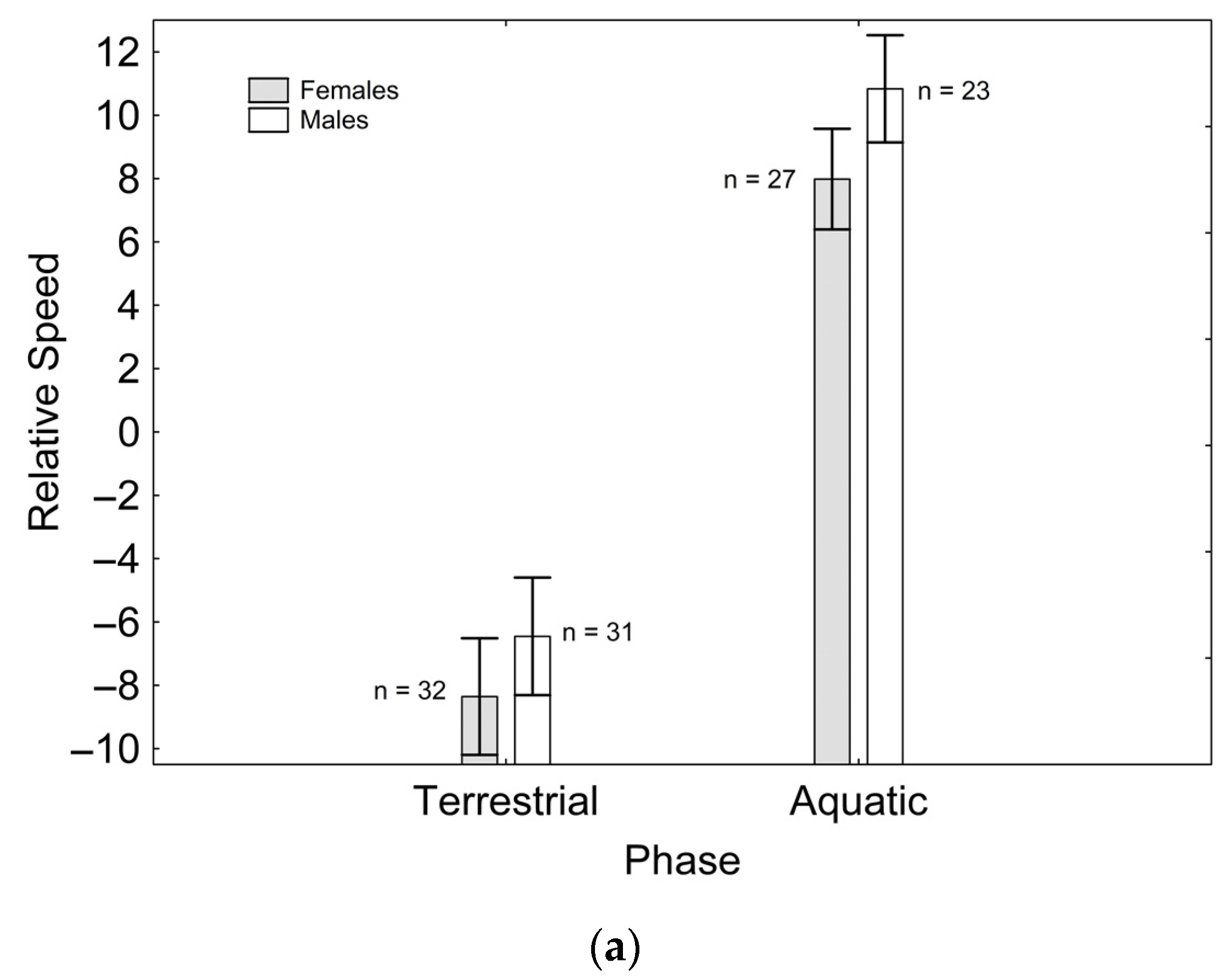
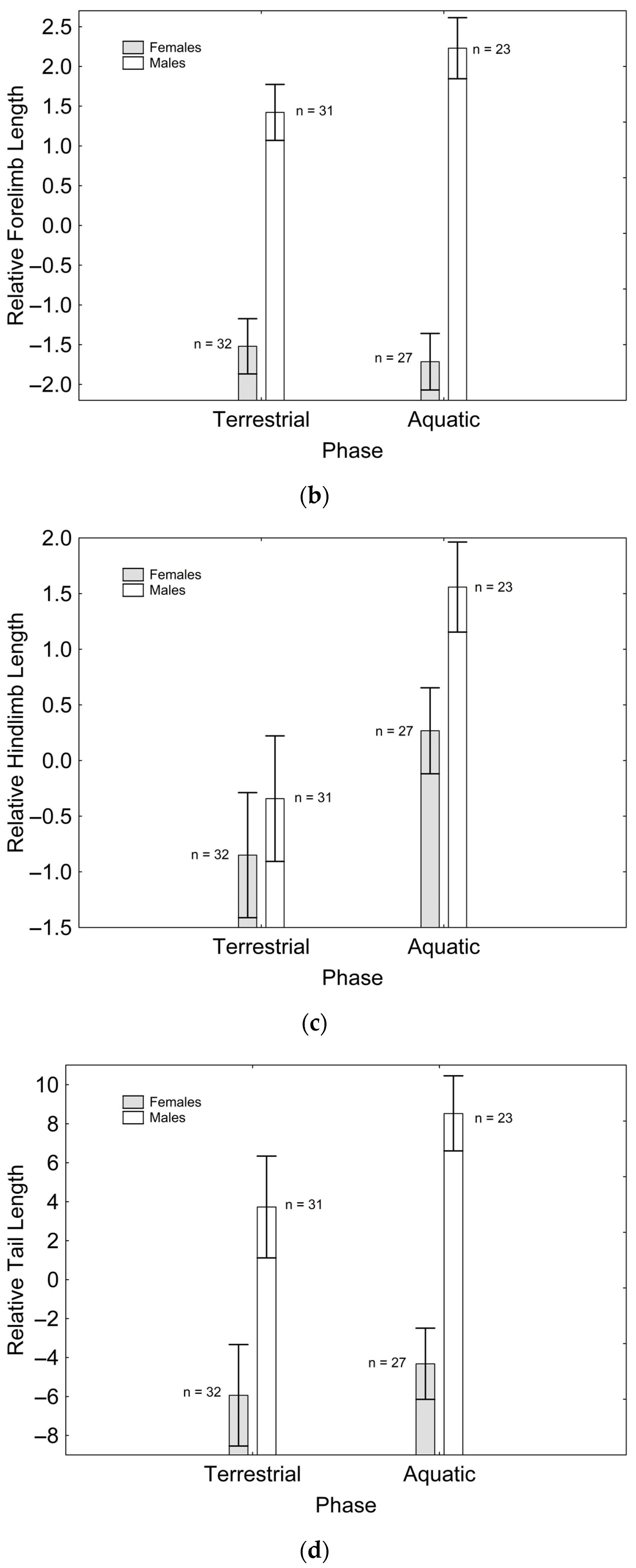
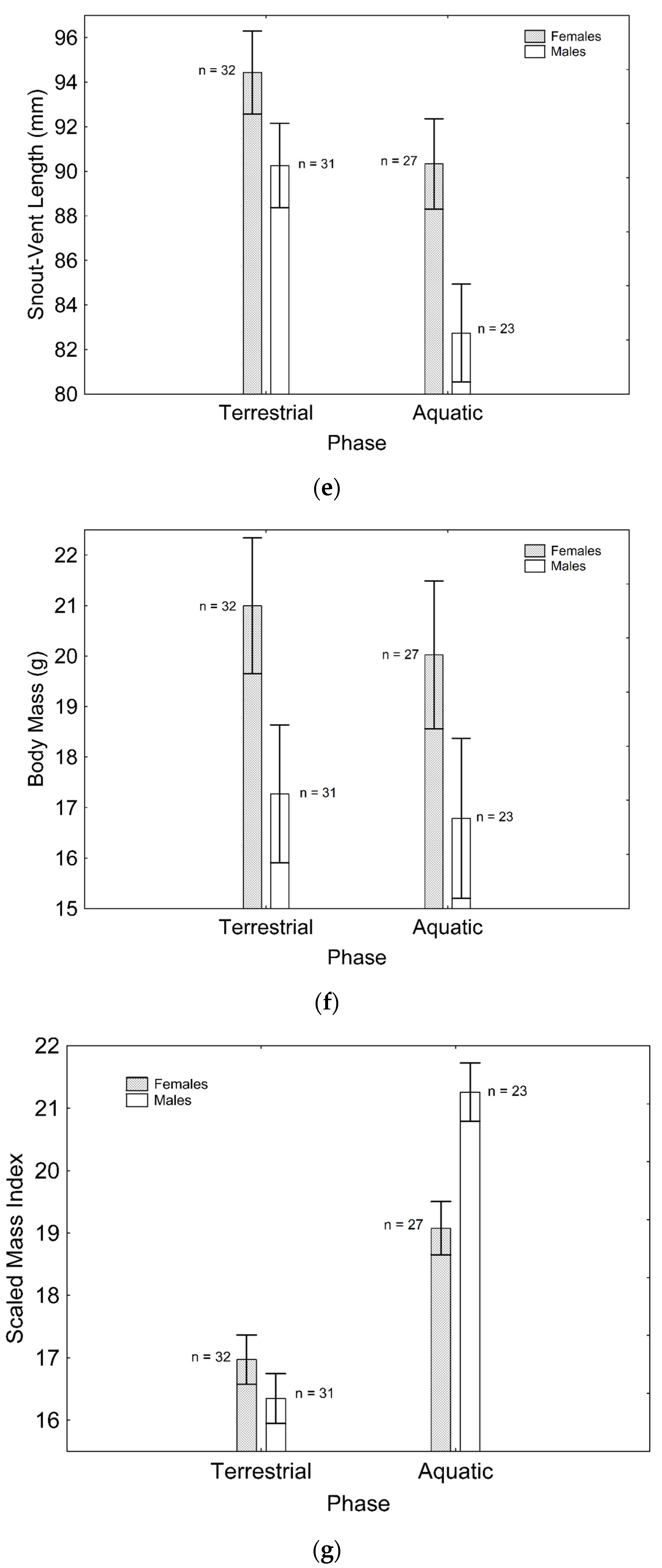
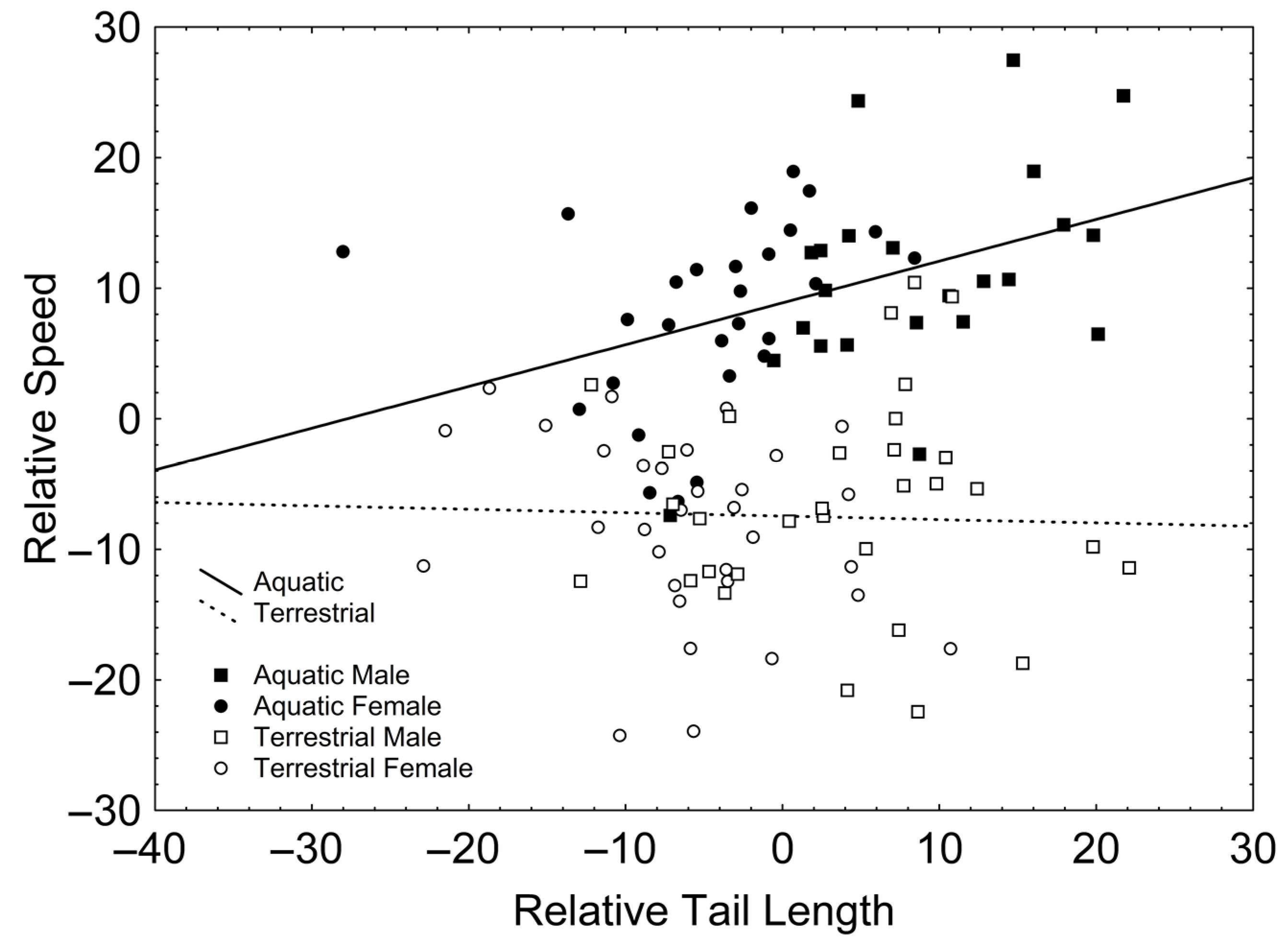
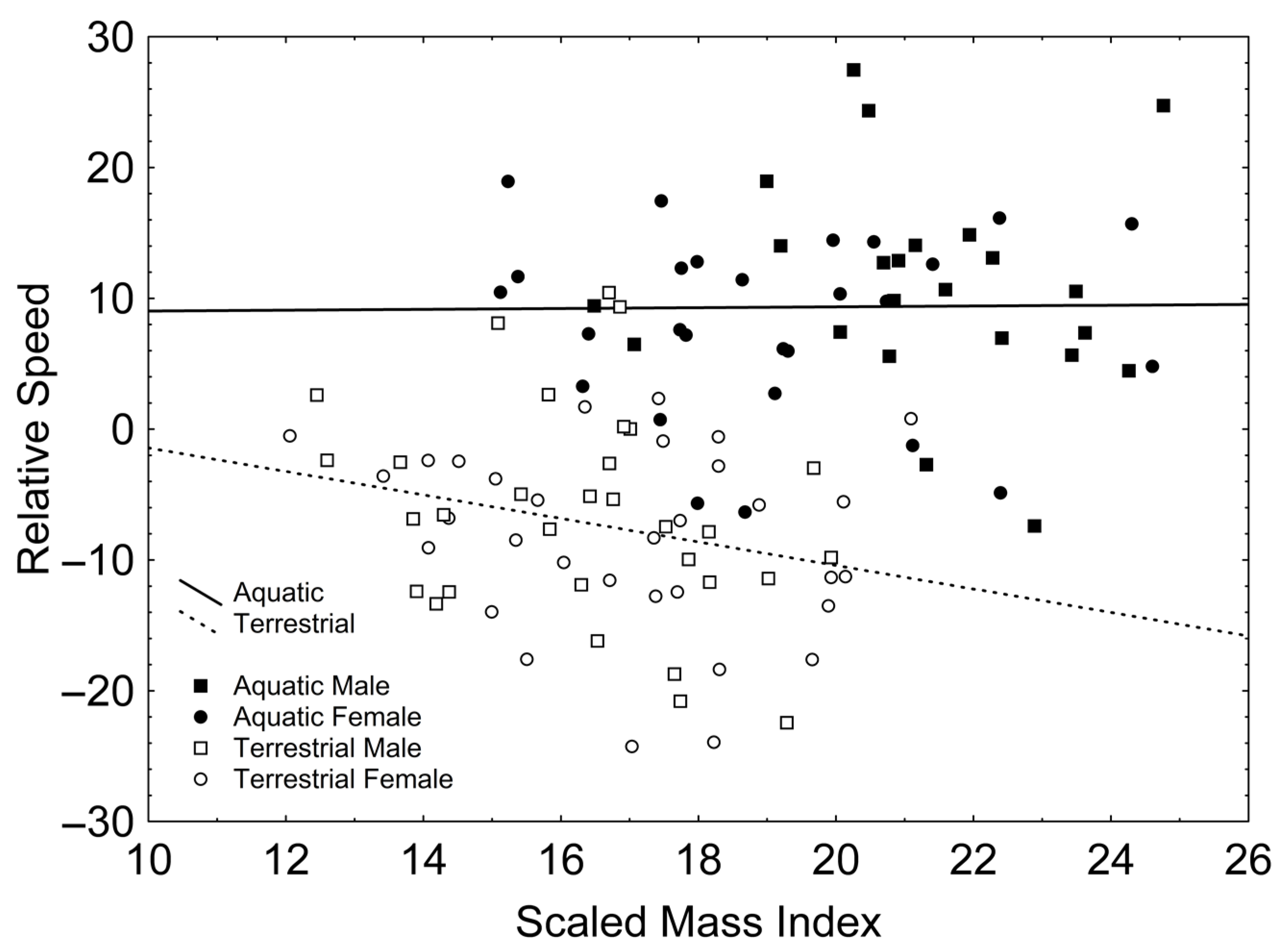
Disclaimer/Publisher’s Note: The statements, opinions and data contained in all publications are solely those of the individual author(s) and contributor(s) and not of MDPI and/or the editor(s). MDPI and/or the editor(s) disclaim responsibility for any injury to people or property resulting from any ideas, methods, instructions or products referred to in the content. |
© 2023 by the author. Licensee MDPI, Basel, Switzerland. This article is an open access article distributed under the terms and conditions of the Creative Commons Attribution (CC BY) license (https://creativecommons.org/licenses/by/4.0/).
Share and Cite
Zamora-Camacho, F.J. Morphological Correlates of Locomotion in the Aquatic and the Terrestrial Phases of Pleurodeles waltl Newts from Southwestern Iberia. Diversity 2023, 15, 188. https://doi.org/10.3390/d15020188
Zamora-Camacho FJ. Morphological Correlates of Locomotion in the Aquatic and the Terrestrial Phases of Pleurodeles waltl Newts from Southwestern Iberia. Diversity. 2023; 15(2):188. https://doi.org/10.3390/d15020188
Chicago/Turabian StyleZamora-Camacho, Francisco Javier. 2023. "Morphological Correlates of Locomotion in the Aquatic and the Terrestrial Phases of Pleurodeles waltl Newts from Southwestern Iberia" Diversity 15, no. 2: 188. https://doi.org/10.3390/d15020188
APA StyleZamora-Camacho, F. J. (2023). Morphological Correlates of Locomotion in the Aquatic and the Terrestrial Phases of Pleurodeles waltl Newts from Southwestern Iberia. Diversity, 15(2), 188. https://doi.org/10.3390/d15020188






